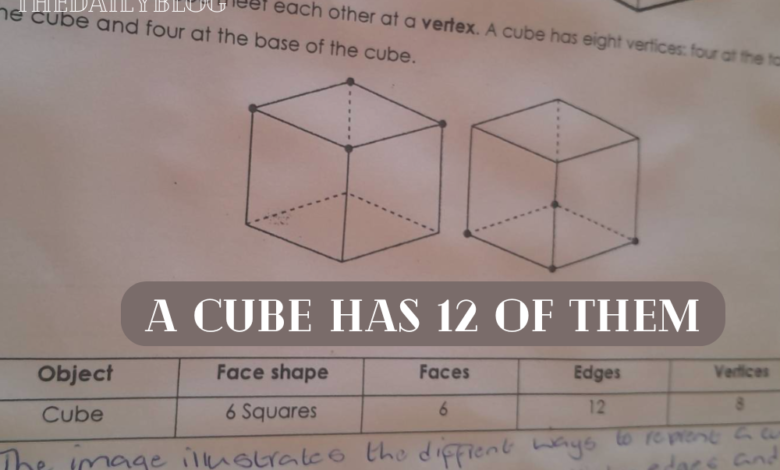A Cube Has 12 of Them Understanding The Geometry Behind a Cube

In the world of geometry, a cube is one of the most fundamental shapes that we encounter. It is a 3-dimensional solid object with six square faces, twelve edges, and eight vertices. In this article, we will dive deep into the characteristics of a cube, explore the importance of its 12 edges, and answer some frequently asked questions related to the topic.
What is a Cube?
A cube, also known as a regular hexahedron, is a type of polyhedron that has six faces, each of which is a square. All of its angles are right angles, and all of its edges are equal in length. A cube is one of the five Platonic solids, meaning it has identical faces and is highly symmetrical. This symmetry is one of the reasons why the cube is such a useful and familiar shape in mathematics and science.
A Cube Has 12 of Them: The 12 Edges of a Cube
When we say, “a cube has 12 of them,” we are referring to the 12 edges of the cube. The edges of a cube are the line segments where two faces meet. These edges are of equal length, making the cube a very symmetrical shape. The arrangement of these 12 edges is crucial for the cube’s structural integrity and spatial properties.
Properties of Cube Edges
The 12 edges of a cube have several important characteristics:
- Equal Lengths: All edges of a cube are congruent, meaning they have the same length. This property contributes to the cube’s uniformity and symmetry.
- Perpendicular Arrangement: The edges of a cube are arranged in a way that they meet at right angles, forming 90-degree angles at each corner. This arrangement is what gives the cube its rigid structure.
- Adjacent Faces: Each edge is shared by two adjacent square faces of the cube. Since the cube has six faces, each face shares its edges with the adjacent faces, resulting in a total of 12 edges.
Visualizing the Edges of a Cube
To visualize the 12 edges of a cube, imagine a square box. Each edge forms the boundary between two faces. You can think of the edges as the “skeleton” of the cube, providing the framework that holds the shape together. These edges are a key feature that defines the cube’s geometry and structure.
Also Read: A Lot to Like NYT Crossword A Fun and Engaging Puzzle Challenge
The Importance of the 12 Edges in Various Fields
The concept of “a cube has 12 of them” is not just relevant in theoretical geometry, but also in practical applications. Let’s explore some areas where the 12 edges of a cube are significant.
Architecture and Engineering
In architecture and engineering, cubes and their edges play a significant role in designing structures. Many modern buildings and designs incorporate cube-like shapes, using their 12 edges to create solid foundations and balanced structures. Whether it’s a simple cube or more complex geometric shapes derived from cubes, the concept of having 12 equal edges is crucial for maintaining symmetry and stability.
Science and Technology
In science, particularly in chemistry and physics, the cubic structure is important. For example, many crystals take the form of a cube, with 12 edges that correspond to the molecule’s atomic structure. The cubic lattice structure of salt (sodium chloride) is a common example where the concept of “a cube has 12 of them” is evident in nature at the microscopic level.
Art and Design
In art and design, geometric shapes like cubes are used for creating visually appealing objects. The cube’s symmetry, with its 12 edges, lends itself to creating aesthetically balanced sculptures and pieces of artwork. Artists often use cubes as the building blocks for their designs, leveraging the equal-length edges to create precise and proportional works.
FAQs
1. How many edges does a cube have?
A cube has 12 edges. These edges are all equal in length and meet at right angles, forming the framework of the cube.
2. Why are the edges of a cube important?
The edges of a cube are crucial because they define the cube’s structure and symmetry. They help maintain the cube’s stability and form. Without these 12 edges, a cubes would not have its distinct geometric properties.
3. Can a cube have different lengths for its edges?
No, in a standard cubes, all 12 edges are of equal length. If the edges were of different lengths, the shape would no longer be a cube but rather another form of a rectangular prism.
4. Are the 12 edges of a cube connected to its faces?
Yes, the edges of a cube are the line segments where two faces meet. Each face of a cubes shares its edges with adjacent faces, resulting in a total of 12 edges.
5. What real-world objects resemble a cube?
Many everyday objects resemble a cube, such as dice, building blocks (like LEGO blocks), and certain boxes or containers. These objects all share the geometric property of having 12 equal edges.
Conclusion
The phrase “a cube has 12 of them” refers to the 12 edges that define the shape of the cube. These edges are vital to the cube’s geometry, providing structure, symmetry, and stability. From the design of buildings to the study of crystals in science, the 12 edges of a cube are essential in various fields. Understanding this fundamental geometric feature enhances our appreciation of the cube and its applications in the world around us.





